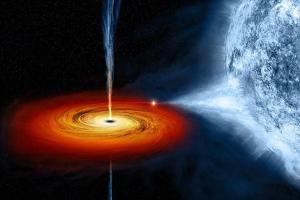Cygnus X-1: A black hole whose mystery is finally unravelled
Saturday, November 19th, 2011 1:31:35 by Taimoor Tariq
Cygnus X-1: A black hole whose mystery is finally unravelled
For the first time in history, astronomers have been able to produce a complete description of a black hole. A black hole is concentration of mass that is so dense, even light can’t escape its powerful gravitational pull.
Using several telescopes, both ground-based and in the orbit, scientists were able to unravel the longstanding mysteries about Cygnus X-1 which is a famous binary-star system. X-1 was discovered emitting X-Rays almost 50 years ago and consists of a black
hole and a star from which the black hole draws material.
The scientists have now succeeded in yielding the most accurate measurements of the mass and spin rate of the black hole.
"Because no other information can escape from a black hole, knowing its mass, spin, and electrical charge gives a complete description of it," said Mark Reid, of the Harvard-Smithsonian Center for Astrophysics (CfA). "The charge of this black hole is nearly
zero, so measuring its mass and spin make our description complete," he added.
Since its discovery, many Astrophysicists have studied the Cygnus X-1. However, previous efforts to determine the mass and spin failed largely due to lack of precise measurements of the black hole’s distance from the Earth.
Reid led a team that used the National Science Foundation’s Very Long Baseline Array (VLBA), a continent-wide radio-telescope system, to make a direct trigonometric measurement of the distance. Their VLBA observations provided a distance of 6070 light-years,
while previous estimates had ranged from 5800-7800 light-years.
With the aid of precise distance measurement instruments, the Chandra X-Ray Observatory, Rossi X-Ray Timing Explorer, Astrophysics and the Advanced Satellite for Cosmology the attributes of Cygnus X-1 were calculated. The black hole is almost 15 times more
massive than our Sun and spins at the rate of 800 spins/second.
"This new information gives us strong clues about how the black hole was born, what it weighed and how fast it was spinning," Reid said. "Getting a good measurement of the distance was crucial," Reid added.
The slow movement of the black hole means that it is not possible for the black hole to have been produced by a supernova explosion as a ‘kick’ at a high speed initiates the supernova.
"There are suggestions that this black hole could have been formed without a supernova explosion, and our results support those suggestions," Reid said.
Tags: Astrophysics, black hole, Chandra X Ray Observatory, cygnus x 1, gravitational pull, Harvard Smithsonian Center for Astrophysics CfA, Rossi X Ray Timing Explorer, Sun, X rays
Short URL: https://www.newspakistan.pk/?p=4076

















